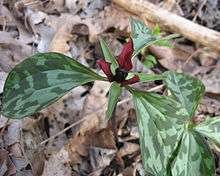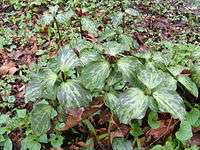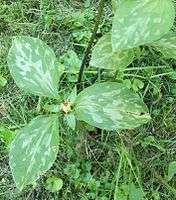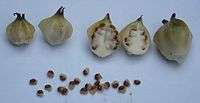Trillium recurvatum
| Trillium recurvatum | |
|---|---|
 | |
| Trillium recurvatum in open flower | |
| Scientific classification | |
| Kingdom: | Plantae |
| Clade: | Angiosperms |
| Clade: | Monocots |
| Order: | Liliales |
| Family: | Melanthiaceae |
| Genus: | Trillium |
| Species: | T. recurvatum |
| Binomial name | |
| Trillium recurvatum L.C.Beck, 1826 | |
| Synonyms[2] | |
| |
Trillium recurvatum, the bloody butcher[3] or prairie trillium, is a spring wildflower in the Melanthiaceae family. It is native to parts of the central and eastern United States, where it is found from Iowa south to Texas and east to North Carolina and Pennsylvania.[4] It natural habitat is mesic forests and savannas, often in calcareous soil.[5][6]
Description
Its flower has three brown to maroon petals that are typically under 3 centimetres (1.2 in) long. The petals are recurved, with tips converging over the stamens.[7] The fruit has 6 well developed ridges (see photo). The seeds include structures known as elaiosomes, to promote dispersal by ants and other foraging insects.
 A population in the early stages of flowering, still in bud
A population in the early stages of flowering, still in bud An individual with mature fruit, late in the summer
An individual with mature fruit, late in the summer Ovaries and seeds
Ovaries and seeds
Conservation status
Trillium recurvatum is common throughout much of its range. It is not considered to be globally threatened, and its status is considered secure.[1] However, it is monitored by conservation agencies in several states at the edge of its range, where it becomes rare. For example, in Wisconsin it is considered rare or uncommon (S3) and therefore a species of special concern.[8] In Michigan, it is considered a state threatened species and is protected by law (S2S3).[9]
| Wikimedia Commons has media related to Trillium recurvatum. |
References
- 1 2 "Trillium recurvatum". NatureServe Explorer. NatureServe. Retrieved June 28, 2009.
- ↑ Kew World Checklist of Seelcted Plant Families
- ↑ "Trillium recurvatum". Natural Resources Conservation Service PLANTS Database. USDA. Retrieved 15 December 2015.
- ↑ Trillium recurvatum web page from Vanderbilt Bioimages
- ↑ "Flora of the Southern and Mid-Atlantic States".
- ↑ Prairie Trillium, web page from Illinois Wildflowers
- ↑ Dan Tenaglia, Trillium Recurvatum web page from Missouri Plants
- ↑ Reflexed Trillium (Trillium revurvatum), Endangered Resources Program Species Information, Wisconsin Department of Natural Resources.
- ↑ Trillium Recurvatum, Michigan Natural Features Inventory, Lansing. (PDF)
